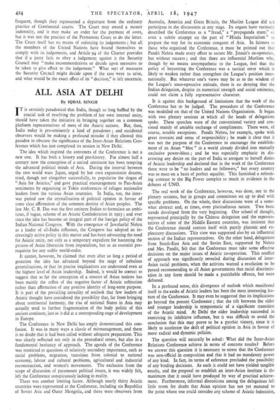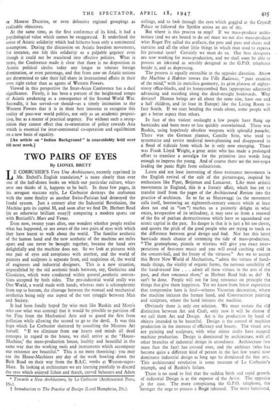ALL ASIA AT DELHI
By IQBAL SINGH
IT is certainly paradoxical that India, though so long baffled by the crucial task of resolving the problem of her own internal unity, should have taken the initiative in bringing together on a common platform representatives of most of the Asiatic nations. But, then, India today is pre-eminently a land, of paradoxes ; and occidental observers would be making a profound mistake if they allowed this paradox to obscure the significance of the Inter-Asian Relations Con- ference which has just completed its session in New Delhi.
The idea which inspired the conveners of the Conference is not a new one. It has both a history and pre-history. For almost half a century now the conception of a united continent has been tempting the advanced political minds of Asia. During the interval between the two world wars Japan, urged by her own expansionist dreams, tried, though not altogether successfully, to popularise the slogan of '" Asia for Asiatics," and gave practical encouragement to Pan-Asian sentiments by organising in Tokio conferences of refugee nationalist leaders from the various Asian countries. In India, too, the inter- war period saw the crystallisation of political opinion in favour of some clear affirmation of the common destiny of Asian peoples. The late Mr. C. R. Das was the first eminent Indian to formulate an ambi- tious, if vague, scheme of an Asiatic Confederation in 1923 ; and ever since the idea has become an integral part of the foreign policy of the Indian National Congress. With the emergence of Jawaharlal Nehru as a leader of all-India influence, the Congress has adopted an in- creasingly active policy in this matter and has been advocating the need for Asiatic unity, not only as a temporary expedient for hastening the process of Asian liberation from imperialism, but as an essential pre- requisite for any stable world-order.
It cannot, however, be claimed that even after so long a period of gestation the idea has advanced beyond the stage of nebulous generalisations, or that its precise implications are understood even at the highest level of Asian leadership. Indeed, it would be correct to suggest that so far the conception of a concert of Asian nations has been mainly the reflex of the negative factor of Asiatic subjection rather than affirmation of any positive identity of long-term purpose. It is part of the prevailing unreality of outlook that few leaders of Asiatic thought have considered the possibility that, far from bringing about continental harmony, the rise of national States in Asia may actually tend to further fragmentation of the body politic of this ancient continent, just as it did at a corresponding stage of development in Europe.
The Conference in New Delhi has amply demonstrated this con- fusion. It was in many ways a classic of mismanagement, and there is no doubt that it had been called without adequate preparation. This was clearly reflected not only in the procedural errors, but also in a fundamental hesitancy of approach. The agenda of the Conference was restricted to questions of relatively secondary importance, such as racial problems, migration, transition from colonial to national economy, labour and cultural problems, agricultural and industrial reconstruction, and women's movements. The exclusion from the scope of discussion of paramount political issues, it was widely felt, left the Conference conspicuously lacking in reality.
There was another limiting factor. Although nearly thirty Asiatic countries were represented at the Conference, including six Republics of Soviet Asia and Outer Mongolia, and there were observers from Australia, America And Great Britain, the Muslim League did not participate in the discussions at any stage. Its organs have variously described the Conference as a " fraud," a " propaganda stunt," or even a subtle attqnpt on the part of " Hindu Imperialism " to prepare the way for its economic conquest of Asia. In fairness to those who organised the Conference, it must be pointed out that Pandit Nehru made every effort to secure Mr. Jinnah's co-operation, but without success ; and that there are influential Muslims who, though by no means unsympathetic to the League, feel that the policy of boycotting the Conference was a tactical error which is likely to weaken rather than strengthen the League's position inter- nationally. But whatever one's views may be as to the wisdom of the League's unco-operative attitude, there is no denying that the Indian delegation, despite its numerical strength and social eminence, could not claim a fully representative character.
It is against this background of limitations that the work of the Conference has to be judged. The procedure of the Conference was modelled on that of the United Nations Organisation. It began with two plenary sessions at which all the heads of delegations spoke. These speeches were of the conventional variety and con- sisted mainly of amiable exchange of compliments. There were, of course, notable exceptions. Pandit Nehru, for example, spoke with great restraint and sense of responsibility ; he made it clear that it was not the purpose of the Conference to encourage the establish- ment of an Asian " bloc " in a world already divided into mutually exclusive power-blocs ; and he was especially emphatic in dis- avowing any desire on the part of India to arrogate to herself duties of Asiatic leadership and declared that in the work of the Conference there were to be " no leaders and no followers," but every country was to meet on a basis of perfect equality. This furnished a refresh- ing contrast to the Big Power complex so much in evidence in the debates of UNO.
The real work of the Conference, however, was done, not in the plenary sessions, but in groups and committees set up to deal with specific problems. On the whole, their discussions were of a some- what abstract and, at times, even platitudinous nature. Two basic trends developed from the very beginning. One school of thought, represented principally by the Chinese delegation and the represen- tatives of some of the Middle Eastern countries, was insistent that the Conference should content itself with purely platonic and ex- ploratory discussions. This view was supported also by an influential section of the Indian representatives. On the other hand, delegations from South-East Asia and the Soviet East, supported by Nehru and Mrs. Pandit, felt that the Conference must take some effective decisions on the major issues of Asiatic co-operation. This conflict of approach was significantly revealed during discussion of inter- Asian racial problems, when the activists wanted a resolution to be passed recommending to all Asian governments that racial discrimin- ation in any form should be made a punishable offence, but were defeated.
In a profound sense, this divergence of outlook which manifested itself in the ranks of Asiatic leaders has been the most interesting fea- ture of the Conference. It may even be suggested that its implications go beyond the present Conference ; that the rift between the older and younger leadership is symptomatic of a significant transition of the Asiatic mind. At Delhi the older leadership succeeded in exercising its inhibitive influence, but it was difficult to avoid the conclusion that this may prove to be a pyrrhic victory, since it is likely to accelerate the drift of political opinion in Asia in favour of more radical and dynamic policies.
The question will naturally be asked: What did the Inter-Asian Relations Conference achieve in terms of concrete results? Before we answer this question it is necessary to stress that the Conference was non-official in composition and that it had no mandatory power of any kind. In fact, its terms of reference precluded the possibility of any-binding decisions. As such it could not have yielded tangible results, and the proposal to establish an inter-Asian institute is the maximum that it could have produied by way of practical achieve- ment. Furthermore, informal discussions among the delegations left little room for doubt that Asian opinion has not yet matured to the point where one could consider any scheme of Asiatic federation,
or Monroe Doctrine, or even defensive regional groupings as realisable objectives.
At the same time, as the first conference of its kind, it had a psychological value which cannot be exaggerated. It underlined the sense of Asiatic solidarity which had hitherto been only a sentimental assumption. During the discussion on Asiatic freedom movements, for instance, one felt this solidarity as a palpable urgency even though it could not be translated into effective policies. What is more, the Conference made it clear that there is no disposition in Asiatic political circles today any longer to tolerate foreign domination, or even patronage, and that from now on Asiatic nations are determined to take their full share in international affairs in their own right rather than as agents of Western Powers.
Viewed in this perspective the Inter-Asian Conference has a dual significance. Firstly, it has been a portent of the heightened tempo of Asiatic awakening as a consequence of the Second World War. Secondly, it has served—or should—as a timely intimation to the Western Powers that it is in their best interests to recognise this reality of post-war world politics, not only as an academic proposi- tion, but as a matter of practical urgency. For without such a recog- nition they cannot effect that re-orientation of policy towards Asia which is essential for inter-continental co-operation and equilibrium on a new basis of equality.
[An article on "Indian Background " is unavoidably held over till next week.]



































 Previous page
Previous page